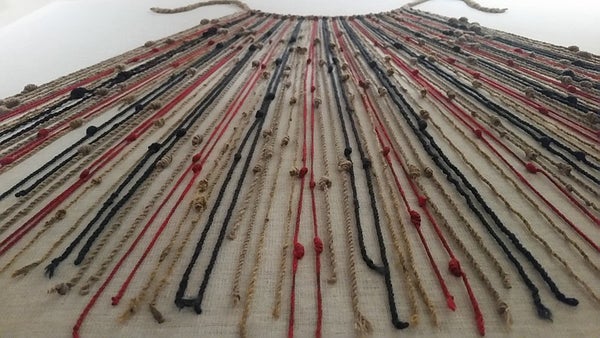This article was published in Scientific American’s former blog network and reflects the views of the author, not necessarily those of Scientific American
Update, June 7, 2020: Gary Urton, the author of Inka History in Knots, has been put on leave by Harvard University due to allegations of sexual harassment.
Imagine that in a few hundred years, archaeologists stumble on some of your old files. Maybe they find spreadsheets of tax information, medical bills, or bank statements, or maybe text files with old emails or drafts of your novel. These archaeologists cannot read Latin script, and no one uses Hindu-Arabic numbers anymore. How do the archaeologists figure out what your files meant? Or can they at all?
The Inka* civilization, which flourished in the fifteenth and sixteenth century and was centered in what is now Peru, used sets of knotted cords called khipus to record information, both quantitative and narrative. Deciphering them has been a challenge, to say the least. I recently read Gary Urton’s book Inka History in Knots: Reading Khipus as Primary Sources, which collects and synthesizes khipu research from his 25 years studying the objects.** It is an invaluable resource for anyone interested in understanding khipus and, more importantly, understanding how and to what extent we can understand them. Scholars have learned to interpret quantitative khipus to a certain degree, but narrative khipus cannot be interpreted at this time.
On supporting science journalism
If you're enjoying this article, consider supporting our award-winning journalism by subscribing. By purchasing a subscription you are helping to ensure the future of impactful stories about the discoveries and ideas shaping our world today.
When I taught math history, I was excited to learn about khipus. When you teach a math history class, it is very easy to end up with a syllabus that covers only Hellenistic and Western European mathematicians and mathematicians. With a little more work, you can incorporate information about ancient Egypt and Mesopotamia and the Islamic world in the Middle Ages. After that, it’s not too hard to throw in some topics related to classical Chinese and Indian mathematics. But engaging with mathematics indigenous to sub-Saharan Africa, Oceania, or the Americas is difficult. Due to colonization by Europeans who believed native people to be intellectually and morally inferior to them and often actively demonized non-European ways of interacting with the world, much knowledge of mathematical thought from those parts of the world has been lost and will probably never be fully reconstructed.
I did not end up teaching khipus in class, in part because of the difficulty I had finding good information about them beyond the very basics that they are knotted cords that can encode a base ten number system. But I did include them as a suggestion for student project topics, and I enjoyed reading student papers about them. Urton’s book would make it easier for a teacher who isn’t a khipu researcher to prepare material for a math history class, but if you are going into the endeavor hoping for a neat and tidy lesson with a satisfying bow on top, you might be disappointed. To me, the most important lesson from the book is about how to approach primary sources from foreign cultures and about the limitations of our understanding of these sources.
Math students are used to seeing material almost as if it has emerged fully-formed from the head of Zeus (or Spivak). The beauty of using primary sources in a math or math history classroom is that they allow students to see how the ideas and understanding of topics changed over time. At its best, a math history class gets students to probe how we know what we know and how the way we understand mathematics and even what mathematical questions we ask are shaped by our culture.
Khipus provide ample chances to ask those questions and take a peek into the archaeological and anthropological methods researchers use to study them. I was fascinated by Urton’s descriptions of where and how the khipus were found, and I appreciated Urton’s detailed explanations of what is known and clear delineations when he was moving towards material that was more speculative, as in the case of his interesting hypothesis that the demographic collapse of the Inka population due to the Spanish invasion is stored in khipus.
Khipus record information in ways I found surprising. Aside from the numbers of knots and their positions on a khipu, the color, direction of twisting, and perhaps even fiber composition of the cords may also have had meaning. The concept of duality, which was important to the Inka people, may be encoded in khipu. If and when we are able to interpret narrative khipu, they may record stories or histories in ways that are completely unlike European linear, chronological narratives.
For more resources on khipus, check out the Khipu Database Project.
* Inka is often spelled Inca, and khipu is often spelled quipu. I am taking Urton’s lead and using the spellings he does in the book. Inka and khipu are the Quechua spellings of these words. Quechua was the primary language of the Inka Empire and is still spoken in parts of the Andes mountains.
**A previous version of this post misstated Gary Urton's name. I apologize for the error.
